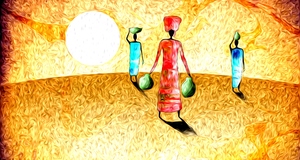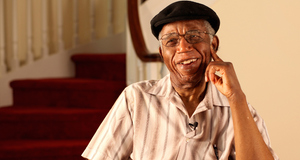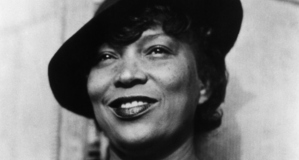Implicit Negritude in The Dark Child
By
2012, Vol. 4 No. 02 | pg. 1/1
IN THIS ARTICLE
KEYWORDS
In James Kirkup and Ernest Jones’ English translation of Camara Laye’s 1953 autobiography, The Dark Child, there is a significant stylistic decision in the final sentence. Kirkup and Jones’ version reads: “Later on I felt something hard when I put my hand in my pocket. It was the map of the métro…” (Laye 188). Laye wrote the memoir in French, and the final sentence reads as such in the original version: “Plus tard, je sentis une épaisseur sous ma main: le plan du métro gonflait ma poche” (Laye 174, French edition). Kirkup and Jones’ translation is significant in that it keeps the word “metro” in French and italicizes it for emphasis. It should be noted that such a decision superimposes the translator’s perception of the sentence’s meaning, thereby influencing the reader’s understanding of the book and possibly misrepresenting the author’s original intent. Because Kirkup and Jones’ version was published in 1994, 14 years after Laye’s death, we will never know how he would react to such a change. But what the decision does reveal is that the interpreters recognized the symbolic significance of the metro map, and the implicit theme of Négritude in the memoir. Indeed, the map of the subway is particularly important at this moment in the book. Just as Laye is about to leave his traditional African perception of 1930’s French Guinea and enter the modernity stricken world of Paris, France, the map cements his decision to leave and enter a new, radically different phase of his life. This moment is one of many instances in which Laye implicitly suggests a rejection of colonial French education and society, and an embracement of traditional African values. Although The Dark Child is not an explicit expression of the Négritude literary movement, Laye’s idealistic perception of his hometown, the importance of communality in labor and his sense of alienation in the French education system implicitly suggest an endorsement of Marxism and African tradition in the creation of an anti-colonial, African identity.African IdealismA common critique of The Dark Child is that it portrays a far too idealistic image of colonial Upper Guinea. Yet it is this very idealism that emphasizes his rejection of French colonialism. An early symbol of the idealized African identity is the little black snake. Unlike other snakes, which the men and woman of the community kill at first sight, the little black snake that visits his father is different. His mother tell a young Laye, “My son, this one must not be killed: he is not like other snakes, and he will not harm you; you must never interfere with him” (Laye 22). She then adds, “This snake…is your father’s guiding spirit” (Laye 22). When Laye then questions his father about the snake’s significance, he responds: “That snake…is the guiding spirit of our race…That snake…has always been with us; he has always made himself known to one of us. In our time, it is to me that he has made himself known” (Laye 24). Before interpreting the meaning of the little black snake, it should be noted that the snake making himself known to Laye’s father is significant. Throughout the autobiography, Laye portrays his father in an ideal, almost mystical light. It is obvious to Laye that the snake should show himself to his father, for he is the most skilled blacksmith, the head of their concession, has authority over the other blacksmiths and—most importantly—“Was he not, after all, my father?” (Laye 24) he asks. A recurring theme of the novel, and indeed an entire chapter, is devoted to the attainment of manhood and masculinity. In Laye’s traditional Africa, his father is the absolute conception of the masculinity he hopes to achieve. When later describing his work preparations, Laye wonder if perhaps “he [his father] always came into his workshop in a state of ritual purity” (Laye 37). It is in itself an expression of Négritude that the masculine figure would be idealized in his childhood world. Thus it is only natural that the little black snake, the guiding spirit of their race, would reveal himself to his father, the epitome of Laye’s idealistic African identity. The snake itself is difficult to interpret without being presumptuous. To define the little black snake would be to define the philosophy of Négritude itself—a concept hardly uniform. Thus it may be best to deduce it’s meaning from the definitions Laye provides through his mother and father’s dialogue. It is, to Laye, “the guiding spirit of our race,” a symbol of pan-African identity in opposition to French colonialism. And its significance can perhaps be attributed less to the animal itself, and more to the figure it reveals itself to—his father. Communal Labor and the Implicit Endorsement of MarxismA major theme of the Négritude movement is the embracement of an Afro-specific interpretation of Communism and Socialism. Martinican poet Aime Cesaire, considered an integral figure in the Négritude literary movement, argued that Stalinist Fraternalism simply promoted the idea of ‘advanced peoples’ aiding ‘backwards peoples’ and thus was no better than colonial paternalism (Diagne). Thus he endorsed an approach that was neither too narrow nor universal; he argued for an African path to socialism inspired by the universal humanist perception of Marxism, or, a “Negro African re-reading of Marx” (Diagne). Laye’s childhood observations do not explicitly suggest a specific adoption of such Marxism, but his references reveal that he was influenced by the political movements of his time when writing. When a young Laye goes with his Uncle to participate in the rice harvest, the existence of a communal labor force within his idealistic perception of Africa society indicates an endorsement of socialist values. His uncle happens to harvest the fastest (another instance in which a central male figure in Laye’s life is ideal). Yet despite Laye’s wish to continue working in order to maintain a lead on the others, his uncle stops and reminds him: “Don’t forget that I must not get too far ahead of the others; it would offend them” (Laye 62). The context of the situation is integral. Laye is spending a few days in Tindican, a tiny and seemingly less developed village than his hometown. He has arrived to the delight of his extended family, which marvel at his modern clothes (Laye 47). His belly is described as always full when in Tindican, and his wish to be competitive is undermined by his uncle’s insistence to not offend the others and thus maintain equality. Laye then goes on to note: I do not know how the idea of something rustic…became associated with country people. Civil formalities are more respected on the farm than in the city. Farm ceremony and manners are not understood by the city, which has no time for these things. To be sure, farm life is simpler than city life. But dealings between one man and another…are more strictly regulated. I used to notice a dignity everywhere which I have rarely found in the cities…. The right of others were highly respected. And if intelligence seemed slower it was because reflection preceded speech and because speech itself was a most serious matter. (Laye 62-63) Laye wrote The Dark Child while in Paris, and the influence of Marxism in response to the modernity of European urbanism is evident. Surely, the poorer villages of French colonial Guinea were not this idealistic. But Laye is writing in longing for a traditional childhood environment he then perceived as superior. His glorification of the communal work force in Tindican can be perceived as a rejection of French capitalism and celebration of the socialist ideal, or, the “Negro African re-reading of Marx” (Diagne). Thus it is once again his perception of the African ideal that serves as his implicit rejection of French colonialism and adoption of the Négritude movement. Alienation in the French Educational SystemIt is no coincidence that once Laye enrolls in a French primary school instead of a Koran one his educational experience deteriorates. In chapter six he describes his school punishments as severe, and the lessons as quite difficult. He writes, “I underwent a variety of punishments in that school, and only one thing did not vary—my anguish. One’s love of knowledge had to be very strong to survive these ordeals” (Laye 80). Thus Laye hints that despite the apparent superiority of the French educational system, he learned in spite of its many challenges. The chapter also goes in detail to describe a strict separation by class, noting that there were “fewer beatings in the upper classes” (Laye 80). He then notes that the older student made the young ones suffer, writing, “These older students—I cannot call them ‘comrades’ since they were older and stronger than we, and less strictly supervised—persecuted us in every conceivable way” (82). Do these references to the separation of ‘class’ and ‘comrades’ implicitly suggest a greater social critique? Albeit uncertain, it’s possible that his description of his French primary school experiences is an allegory for the class separation of French capitalism, and thus another symbol of anti-colonialism. Regardless, his negative portrayal of the school and its headmaster infer alienation within the French educational system and a wish to return back to African traditional values—an illustration of Négritude. It also is important to note that his idealistic perception of masculinity, his father, saves him from this ordeal. An Argumentative Memoir?Why did Camara Laye write The Dark Child? It is not a complete story of his life; it is, in fact, only a tiny snippet. It’s unlikely that as a relatively young man living in France, he simply wanted to recount his childhood. Rather, the implicit prevalence of Négritude thought in the book suggests that his story is an argumentative memoir. The aspects of Négritude previously discussed—glorification of masculinity, idealistic perception of traditional African society, aspects of socialist thought and a rejection of French education—do not simply influence Laye’s depiction of his childhood. Instead, he gives us a strategically planned perception of his early life in order to advance certain messages and beliefs. The magical aspects of the book, such as the little black snake and his father’s powers, is symbolic of the Négritude movement’s search for a Pan-African, anti-colonial identity. The events should not be discounted as fiction, but rather fictionalized accounts of real events in order to prove a point. Laye’s memoir, like any memoir, employs a certain amount of creativity and falsehood in order to portray to the reader their life experiences in a certain condition. In addition, the conditions of French colonial Guinea, especially the tiny village of Tindican, could not have been as ideal as Laye describes. The emphasis of the communal workforce, his uncle’s preference for equality and the glorified portrayal of conditions in the village reflect Laye’s dissatisfaction with French colonial society. How much of this attitude is simply revealed in his writing, and how much was purposely employed, is hard to determine. Nonetheless, the exemplary moral condition of Laye’s childhood environment is another strategic portrayal of his actual life experiences. Thus The Dark Child is not merely a memoir. It is a fictionalized depiction of non-fictional events in order to support Laye’s views. In particular, one can see a heavy influence and employment of Négritude thought in his description of his early life. And was Kirkup and Jones’ decision to maintain the last word of the novel in French appropriate? Perhaps not, but in the context of the memoir’s themes and messages, Laye might have approved. ReferencesDiagne, Souleymane. "Négritude (Stanford Encyclopedia of Philosophy)." Stanford Encyclopedia of Philosophy (Summer 2010 Edition). Stanford University, 24 May 2010. Web. 15 Oct. 2011. Laye, Camara, James Kirkup, and Ernest Jones. The Dark Child. New York: Farrar, Straus and Giroux, 1994. Print. Laye, Camara. L'enfant Noir. Trans. Myrna Bell Rochester and Natalie Schorr. Focus, 2005. Print. Suggested Reading from Inquiries Journal
Inquiries Journal provides undergraduate and graduate students around the world a platform for the wide dissemination of academic work over a range of core disciplines. Representing the work of students from hundreds of institutions around the globe, Inquiries Journal's large database of academic articles is completely free. Learn more | Blog | Submit Latest in Literature |


















